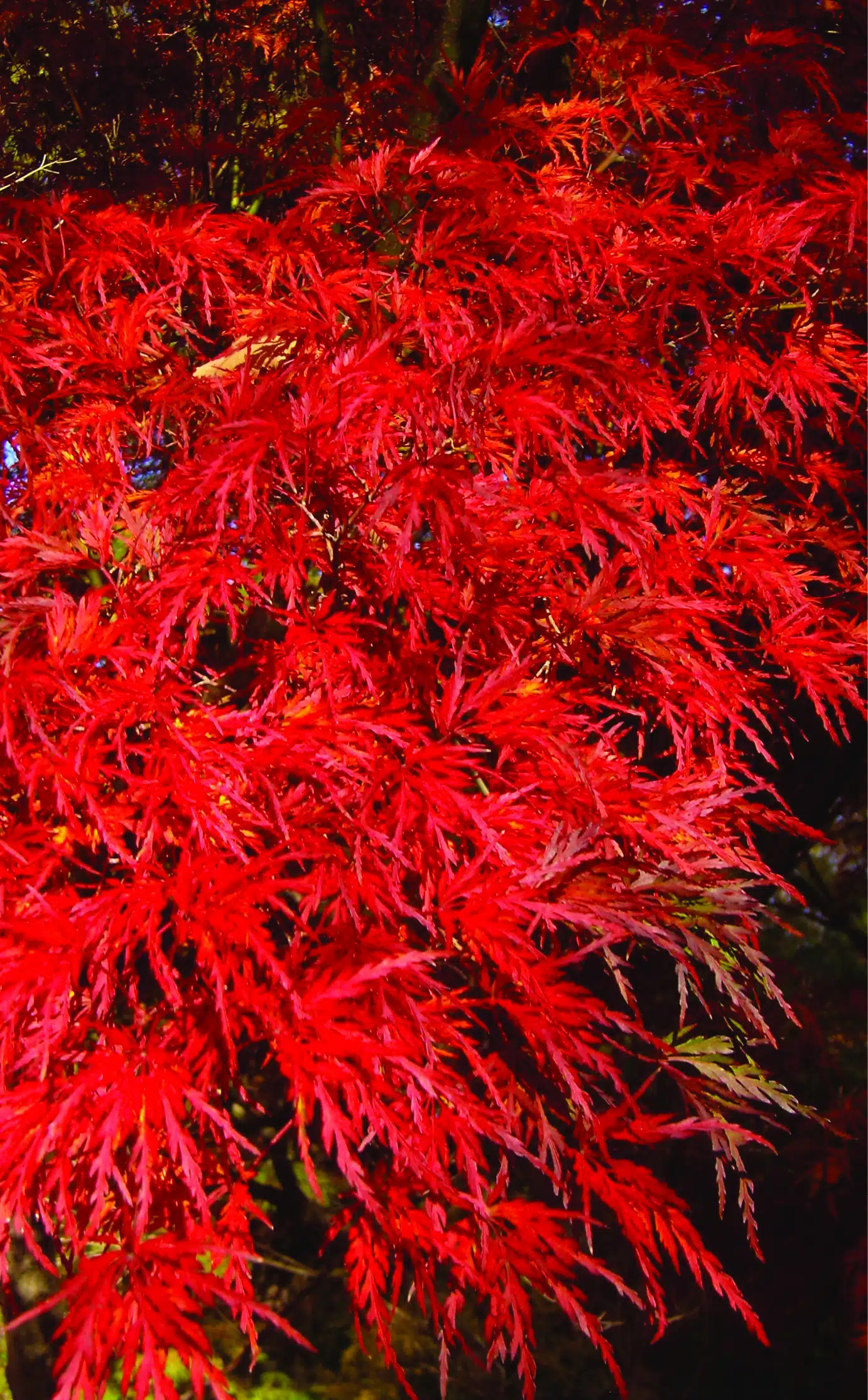Nature Profile
Trees
Japanese maple
Acer palmatum

A beautiful small tree with gorgeous foliage and refined habit, Japanese maple is prized by landscape designers from east to west. The native range of Acer palmatum includes the islands of Honshu, Shikoku and Kyushu in Japan, and southern Korea. The people of Japan have admired and appreciated these trees as far back as the seventh century, and have cultivated numerous selections of distinctive varieties since the 17th century.
Cultivated Japanese maples are grouped with regard to leaf type with the dissectum group, for example, having leaf lobes very deeply divided and deeply dissected into sublobes. At The Holden Arboretum the first specimen of cut leaf Japanese Maples was obtained from Klyn Nurseries in Perry, Ohio, in 1955 and planted at Lantern Court in 1964. It is located on the rise west of the Salamander Pool and now measures about 5.5’ tall by 15’ wide with serpentine branching. The foliage is reddish purple in spring, mixed with green in summer, turning bright orange and yellow for two to three weeks in October and November.
In the Eliot and Linda Paine Rhododendron Discovery Garden the red cutleaf Japanese maple cultivar that was planted in 2012 is ‘Tamuke yama’. It was listed as far back as 1710 and is arguably still the best performer of its group in our climate. The matsumurae group have very deeply divided but not dissected leaves – ‘Burgundy Lace’ is in this group. In the Paine Rhododendron Discovery Garden, the red-leaved ‘Bloodgood’, the standard in the nursery trade, and a relative newcomer, ‘Trompenburg’ are near one another for comparison. A ‘Trompenburg’ planted at Lantern Court in 2004 as a 5’ tall tree now measures 17’ tall and 19’ wide. The fruit of ‘Trompenburg’ are often held upright, which is a distinguishing characteristic of the Shirasawa maple, but not of Japanese maple. Although it is reported in the literature that ‘Trompenburg’ leafs out two weeks later than ‘Bloodgood’, I have not noticed this here and suspect that the observation was made either in Europe or the Pacific Northwest.
In the Helen S. Layer Rhododendron Garden south of Heath Pond three weeping Japanese maples, Acer palmatum ‘Ryusen’, grace Hawgood Hill. Planted in 2014 ‘Ryusen’ needs to be trained to a desired height. At Lantern Court Acer palmatum ‘Seiryu’ a tree-form with deeply dissected leaves turns brilliant reddish shades from late October to early or even mid November in some years. Unfortunately, fall snow storms can bring an abrupt end to the color display and can result in structural damage to the trees. Japanese maples can lose limbs in fall snow storms. The pine-bark Japanese maple, ‘Nishiki gawa’ at Lantern Court lost a limb in Oct. 2013 and suffered significant winter 2014 branch dieback. ‘Seiryu’ also had some dieback. The tendency of both ‘Nishiki gawa’ and ‘Seiryu’ to go dormant later in fall than the Japanese maples that did not suffer dieback suggests late leaf drop as an indicator of questionable winter hardiness in northeast Ohio.
Most Acer palmatum cultivars lost vegetative buds in the winter of 2014 and resorted to producing new leaves from adventitious buds hidden beneath the bark that flushed in mid to late May, 2-3 weeks after the primary buds produced leaves. In some years such as 2012, leaves broke bud by the first week of April, making them prone to hard spring frosts. The Easter freeze of 2007 killed the foliage in April, but new leaves appeared in May and plants recovered fairly quickly. The small purplish-red flowers appear with the new leaves, although none were present in 2014 due to the harsh winter which included a -16 degree F. low in February.
Two of the newly planted trees in the Paine Rhododendron Discovery Garden had bark split on their main trunks that, combined with an infestation of Ambrosia beetles, killed them this spring. Commercial tree wrap serves to prevent winter sun scald and bark split on trunks of thin barked trees such as these. To guard against rodents chewing the bark during winter, hardware cloth can be used.
In the landscape, Japanese maples have become popular, especially the purplish-red foliaged forms with dissected leaves. They are not as expensive as they used to be and are striking in combination with conifers, azaleas, and a number of other plants including Japanese forest grass (Hakonechloa macra ‘Aureola’) that are available in local garden centers. The cutleaf forms typically grow 8-10’ tall after several decades but can be kept to 4-5’ with annual pruning. Winter (late Jan.-Feb.) and summer (June-July) are the best times to prune. To shorten branches, simply cut back stems as close as possible to pairs of side shoots.




